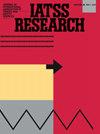德里行人安全认知:一种Rasch分析方法
IF 3.3
Q3 TRANSPORTATION
引用次数: 0
摘要
对建筑环境的安全感知影响着行人的行走和过马路决策。Rasch分析是一种在道路安全领域尚未得到充分利用的心理测量技术,它可以深入了解行人的感知和决策过程。本文基于印度德里的建筑环境特征对行人安全感知进行了评价。使用Rasch技术收集和分析行人对建筑环境的感知,同时计算行人性能和安全结构。分析强调了需要立即干预的关键领域。结果显示,即使是最有能力的行人,大多数与安全相关的结构也超过了安全阈值,这表明德里的一般行人环境对步行不利。本文还讨论了Rasch分析对问卷问题修改的启示,为早期研究者对问卷设计提供了有价值的见解。本文章由计算机程序翻译,如有差异,请以英文原文为准。
Perceptions of pedestrian safety in Delhi: A Rasch analysis approach
Safety perception about the built environment influences a pedestrian's walking and crossing decisions. Rasch analysis, a relatively underutilized psychometric technique in the road safety domain, can provide deep insights into pedestrian's perceptions and decision making process. This paper evaluates pedestrian safety perception based on built environment features in Delhi, India. Pedestrians' perceptions of built environment was collected and analyzed using the Rasch technique to simultaneously compute pedestrian performances and safety constructs. The analysis highlights key areas that need immediate interventions. Results revealed that most safety-related constructs are beyond the safety thresholds of even the most capable pedestrians, suggesting that the general pedestrian environment in Delhi is hostile to walking. This paper also discusses the implications of Rasch analysis for revising survey questions, providing valuable insights for early researchers about survey questionnaire design.
求助全文
通过发布文献求助,成功后即可免费获取论文全文。
去求助
来源期刊

IATSS Research
TRANSPORTATION-
CiteScore
6.40
自引率
6.20%
发文量
44
审稿时长
42 weeks
期刊介绍:
First published in 1977 as an international journal sponsored by the International Association of Traffic and Safety Sciences, IATSS Research has contributed to the dissemination of interdisciplinary wisdom on ideal mobility, particularly in Asia. IATSS Research is an international refereed journal providing a platform for the exchange of scientific findings on transportation and safety across a wide range of academic fields, with particular emphasis on the links between scientific findings and practice in society and cultural contexts. IATSS Research welcomes submission of original research articles and reviews that satisfy the following conditions: 1.Relevant to transportation and safety, and the multiple impacts of transportation systems on security, human health, and the environment. 2.Contains important policy and practical implications based on scientific evidence in the applicable academic field. In addition to welcoming general submissions, IATSS Research occasionally plans and publishes special feature sections and special issues composed of invited articles addressing specific topics.
 求助内容:
求助内容: 应助结果提醒方式:
应助结果提醒方式:


